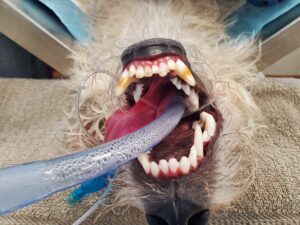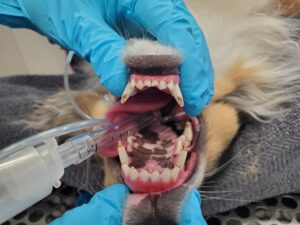
12 Apr What does it mean when dog teeth aren’t pearly white?
The normal color of a healthy dog or cat tooth is the same as it is for people – a shiny, creamy white or off-white. While dogs don’t have the problem of staining from too much coffee or red wine, that doesn’t mean their teeth are always shiny and white. Is this a problem? Sometimes, but sometimes not. Our team at Animal Dental Care & Oral Surgery will explain why dog teeth aren’t pearly white and signs to look out for.
Four Common Reasons for Discolored Teeth in Dogs
Dental Calculus
In some cases the tooth isn’t discolored at all, but rather hidden by a layer of dental calculus (also known as tartar). Dental calculus is composed of mineral material and bacteria and is a form of hardened plaque. It usually has a yellow to brown to grey color and an irregular or bumpy appearance. The good news is that it can be easily cleaned off with professional dental cleaning! Dental home care like tooth brushing will not remove calculus from teeth once it has formed.

Enamel Defects & Staining
Animals can sometimes have defects in their enamel (the hard, outer, shiny layer of the tooth), which reveal the material underneath, called dentin. Dentin takes up stain more readily than enamel, so the area may have a brown tinge to it. Staining can also occur with normal enamel. Staining on its own is not usually a concern, but teeth with damaged enamel should be evaluated by your Veterinary DentistTM to be sure that the rest of the tooth remains healthy.

Staining without enamel defect

Staining with enamel defect
Reparative (Tertiary) Dentin
When animals wear their teeth overtime, they can wear through the enamel and into the dentin. If the wear happens slowly enough, the tooth can protect itself by laying down a new layer of dentin (called reparative or tertiary dentin) to protect itself. This material is usually a tan to brown color. These teeth often do not require treatment, but any dog with excessive wear or damage to their teeth should be evaluated by your Veterinary DentistTM.

Intrinsically Stained Teeth
Occasionally, a tooth (or part of a tooth) will become discolored after sustaining trauma. The living tissue inside the tooth, called the pulp, can bleed and stain the dentin within the tooth, giving the tooth a pink, purple or grey hue. Studies have shown that over 92% of these teeth are dead, which means they require treatment, such as root canal treatment or extraction, to prevent a painful abscess or infection from forming.

Veterinary Dentist in Fort Collins
Any time you notice that your dog’s teeth aren’t pearly white or see other changes in the appearance of your pet’s teeth (or one of their teeth), it is important to schedule an appointment with your Veterinary DentistTM. Your vet dentist can determine if the cause is something that could cause your pet pain or infection, or if treatment is required.
Photo by Mali Maeder from Pexels



